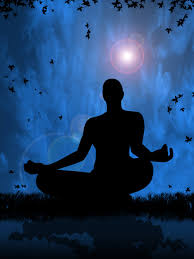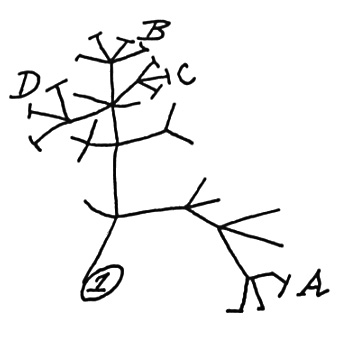A large, red, cup-shaped leaf, its stem pointing straight down, parachutes into the creek in the windless air and is instantly swept downstream on the clear current of death, and life.
 At the end of over an hour’s passive observation, there is only the rippling water and the quiet earth. The mind is still and the heart is open. The man-made world is there, right behind the hedge across the stream, but like the mind-as-thought, it has receded into unimportance.
At the end of over an hour’s passive observation, there is only the rippling water and the quiet earth. The mind is still and the heart is open. The man-made world is there, right behind the hedge across the stream, but like the mind-as-thought, it has receded into unimportance.
Meditation is essentially the ending of every form of continuity of thought in undirected attention to what is. To be happy is to be complete, and to be complete is to end all continuity of thought. Why do we believe that happiness involves continuation of some kind, when it is actually just the opposite?
Imagination is anathema to meditative states, as is concentration, whether on a mantra or one’s breath. Tai Chi, running or even knitting can be meditative, but they can’t awaken meditative states. One can perhaps watch one’s breath sitting indoors, if one is not focused on it but inclusively aware of every sound and sensation.
“Regaining control of my attention” is a triple falsehood. Control and attention are antithetical; ‘my attention’ is completely inattentive; and attention is never regained, but is gathered anew each day.
The movement of thought is the movement of time, so when thought spontaneously falls silent in intense, undirected attention, time ends. Passive observation without the observer is the action, or inaction that gathers unwilled attention, which in turn is the only power that can completely quiet and empty the mind.
Speaking personally, I still require the mirror of nature for passive watchfulness to gather sufficient attention to quiet thought and end time. Sometimes there will be a spontaneous shift in consciousness while being mindful with others, or even walking in a mall or city. But complete meditation only occurs when one is sitting and enjoying listening and watching nature.
Whether outdoors or indoors, it’s essential to have no goal and make no effort. Play with watchfulness. Experiment with observation. Question your thinking and assumptions. Feel every sensation, but don’t seek pleasure. And turn off your cell phone for a half hour or hour, and with it the illusion of connection with others.
In short, one has to claim some space each day, with the deep intent (not the intention, which is the product of self and will) to quiet thought and end time.
Beyond the individual (as opposed to the personal) aspects of meditation, what is the relationship between higher states of consciousness and the crisis of man and consciousness?
A transmutation of the human species is urgently necessary, and merging with our machines or fucking with our genes cannot bring it about (pardon my French).
It’s interesting to consider the question of conscious transmutation in the light of two contemporary scientists, Charles Darwin and Louis Agassiz. As Lisa Randall says, “both Agassiz and Darwin were born naturalists, recording the details and distinguishing characteristics of animals as seen in their environment and in the fossil record.”
“But whereas Darwin considered this evidence in favor of evolution, Agassiz saw evidence that species remained fixed.” That was mostly due to the incompleteness of the fossil record at the time. “Before Agassiz accepted Darwin’s idea of ‘transmutation’—that is, the formation of new species from older species—he wanted to see concrete evidence in the fossil record that one ‘variant’ preceded another.”
Ironically, the vast majority of philosophers and scientists today take Agassiz’ rather than Darwin’s view where humankind is concerned. They maintain, explicitly or implicitly, that ‘human nature’ is immutable, and that any further evolution of our species will only occur through technological fusion or genetic manipulation.
How can human transmutation be brought about through the cognitive dimension that has produced this untenable fragmentation of the earth and humanity? It cannot. Our transmutation as individuals and a species has to come through another, virtually untapped capacity. That capacity is awakened with attention, not concentration, which opens the brain to the state of insight, rather than merely the accumulation memory and knowledge.
Ending the continuity of thought in all its forms and faculties is the pathless path to transmutation of the individual and the species. Bringing about one’s own transmutation as a microcosm of the whole of humanity is a matter of gathering sufficient attention to end thought/time each day.
The essence of the work within the human mind and heart turns on the question of continuity or ending, accretion or negation, and the tyranny of thought or the liberation of insight.
Martin LeFevre

